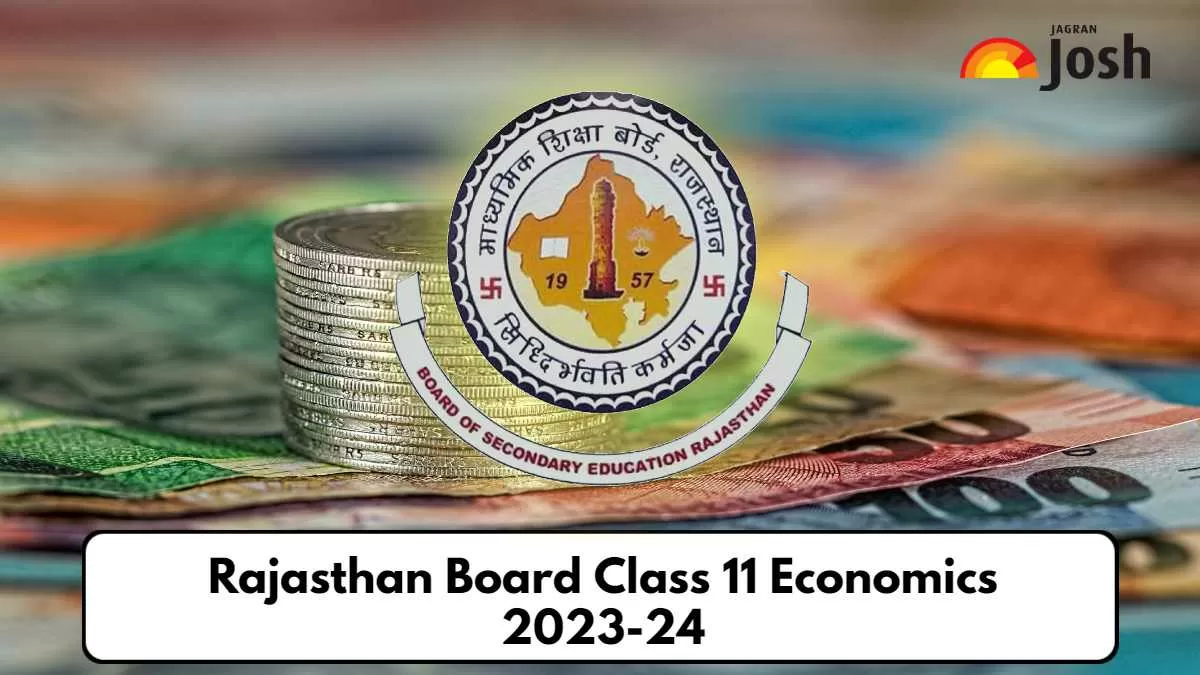Rajasthan Board Class 11 Economics Syllabus for 2024 Exam: RBSE, the Rajasthan Board of Secondary Education, has published its syllabus for all its higher secondary and intermediate courses. Students will now be able to check and download the new syllabus for the academic year 2023–24. The new syllabus is important, as the board may have revised the syllabus by deleting a few topics in accordance with the National Education Policy 2020 and revised NCERT Class 11 textbooks.
You can read and download the newly published Rajasthan Board Class 11 Economics Syllabus 2023–24 from here. The detailed unit-wise weightage is given below, which you can follow to give preference to units during the exam time. The paper will be of 100 marks and will be framed from 8 units of RBSE Class 11 Economics. To get more information, read this article.
Read: RBSE Class 11th Syllabus 2023–24: Download the New Syllabus PDF, Subject-Wise List
राजस्थान बोर्ड 11th Economics Course Structure 2024
| Unit No. | Unit Name | Marks Allocated |
| I | Statistical Methods | 10 |
| II | Statistical Presentation | 12 |
| III | Statistical Measures | 12 |
| IV | Statistical Uses | 16 |
| Section B: Indian Economy Development | ||
| I | Development Policies and Experience (1947-90) | 12 |
| II | Economic Reforms Since 1991 | 12 |
| III | Current Challenges facing the Indian Economy | 20 |
| IV | Development experience of India: A Comparison with Neighbors | 06 |
| Total | 100 |
RBSE Class 11th Economics Syllabus 2023-24
| Unit I: Statistical Methods |
| 1. Introduction- Subject Matters of Economics, Statistics in Economics, Meaning of Statistics, Importance of Statistics. 2. Collection of data- Purpose of data collection, sources of data, mode of data collection. Census and sample survey, sampling and non-sampling errors, census of India and National Sample Survey. |
| Unit II: Statistical Presentation |
| 3. Organization of data- Introduction, Raw data, Classification of data variables: continuous and discrete. Frequency distribution, Bivariate frequency distribution. 4. Presentation of Data-Introduction, Textual and Tabular Presentation of Data and Tabulation of Data, Parts of a Table, Diagrammatic Presentation of Data, Geometrical Diagram, Frequency Diagram (Histogram, Frequency Polygon, Frequency Curve, Ogive ), Arithmetic line graph |
| Unit III: Statistical Measures |
| 5. Measures of Central Tendency- Introduction, Arithmetic Mean Weighted Arithmetic Mean, and Median, Quartiles, Percentile, Mode. Relative position of Arithmetic Mean, Median and Mode. |
| Unit IV: Statistical Uses |
| 6. Correlation - Meaning of Correlation, Types of Correlation, Techniques for Measuring Correlation: Scatter Diagram, Karl Pearson's Coefficient of Correlation, Spearman's rank Correlation. 7. number-the Aggregative Method, Method of Averaging relatives. Some important Index number Consumer Price Index. Wholesale Price Index. Index of Industrial Production, Human Development Index, Sensex, Issues in the construction of an Index number. Index number in Economics. 8. Use of Statistical tools-introduction, steps towards making a Project, Suggested List of Projects. Sample Project. |
| Section B: Indian Economy Development |
| Unit I: Development Policies and Experience (1947-90) |
| 1. Indian economy on the eve of independence Low level of economic development under the colonial rule, agricultural sector, industrial sector, foreign trade, demographic condition. Occupational structure. Infrastructure. 2. Indian Economy (1950-90) The Goals of Five Year Plans, Agriculture, Industry and Trade, Trade Policy: Import Substitution. |
| Unit II: Economic Reforms Since 1991 |
| 3. Liberalizations, Privatization and Globalization An appraisal- Background, Liberalizations Privatization, Globalization, Indian Economy during Reform: An assessment. |
| Unit III: Current Challenges Facing the Indian Economy |
| 4. Human Capital Formation in India - Meaning of Human Capital, Sources of Human Capital, Human Capital and Human Development, State of Human Capital Formation in India Growth in Government Expenditure on Education, Future Prospects. 5. Rural Development Meaning of Rural Development, Credit and Marketing in Rural Areas, Agricultural Market System, Diversification into Productive activities Sustainable Development and Organic farming. 6. Employment Growth Informalization and other issues- Workers and Employment, participation of people in employment, self-employed and hired workers, employment in firms, factories and offices, growth and changing structure of employment, in formalization of Indian workforce. unemployment government and employment generation. 7. Environment and Sustainable Development - Environment Definition and Functions. State of India's Environmental Sustainable Development, Strategies for Sustainable Development. |
| Unit IV: Development Experience of India: A Comparison with Neighbors |
| 8. Comparative Development Experiences of India and its Neighbours - Development path. Demographic Indicators, Gross Domestic Product and Sectors, Indicators of Human Development, Development strategies and appraisal. |
